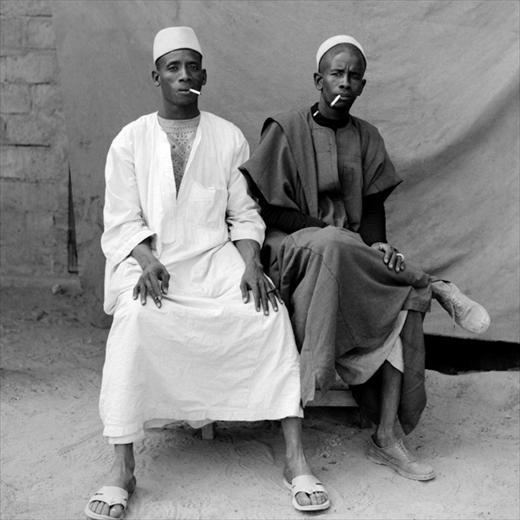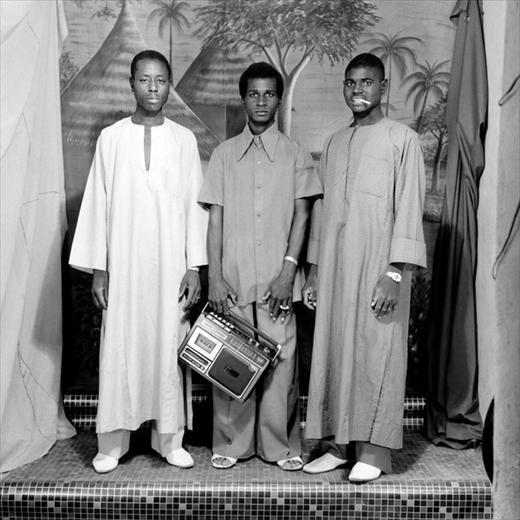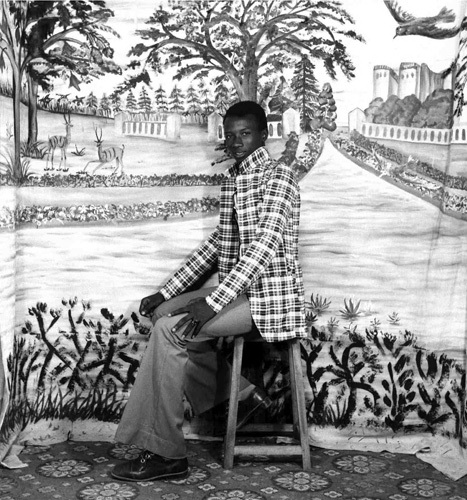Initially trained in Timbuktu as a mason, Maiga’s career as a photographer was launched in the early 1950s when he purchased his first camera, a medium format Souflex. At the age of twenty he learnt the rudiments of photography and printing through photojournalism, and in 1958 Maiga opened his first studio in N’Gouma. For two years he traced the route of the River Niger developing a clientele for his distinctive outdoor studio portraits. In 1960 he returned to Timbuktu with a successful business.
As well as villagers in their finery, a swathe of dignitaries, accomplished artists, musicians, sportsmen and religious authorities frequented Maiga’s studio. During these early years, his photographs eloquently portray Malian society in its era of transition from a cosmopolitan French colony to an independent African nation. Balancing a strict sense of formality with a remarkable level of intimacy with his subjects, Maiga evokes stylistic traits simultaneously mastered by Irving Penn in the seminal Worlds in a Small Room.
In 1973 Maiga opened his first studio in Bamako. The period following independence from France experienced a great sense of freedom and confidence combined with economic expansion. European and American fashions became readily available to a Malian audience and energised local culture. Maiga constructed each image using a mixture of carefully chosen props, costume and painted backgrounds, giving them a new graphic intensity with black and white film. His subjects would dress like their idols and a specific film or look would dictate the way they wore their jackets or held their cigarettes. These unique images reflect both his client’s social identity within the community and their enthusiastic embrace of modernity.
As well as forming an outstanding record of Malian society, Maiga engages his subjects in a style recalled by contemporary artists such as Rineke Djikstra. While his precursor Seydou Keita and contemporary Malick Sidibe have achieved international recognition by museums, collectors and publishers worldwide, Maiga’s archive of negatives has only just come to light.
Hamidou was born in 1932 in Bobodioulasso, Burkina Faso. Today he continues to live and work in Bamako.

Text by Lucia Davies
Here we speak to 79-year-old Maiga who continues to live and work in Bamako. With thanks to Maiga’s son for acting as the translator in this interview.
Hamidou Maiga, Talking Timbuktu runs 23 March – 30 April at Jack Bell Gallery, London.Lucia Davies is the AnOther Editorial Assistant and a regular contributor to Dazed Digital. She has also contributed to titles that include Dazed & Confused, The Independent, It’s Nice That, Glass and Twin Magazine.
How did you first get into photography?
I was surprised to find how poor the quality was of the photography available at the time. I decided to learn the art in Mopti – to make high quality images and then take up the profession in Timbuktu. Photojournalism was the best avenue to go down to perfect these skills. Having completed my apprenticeship I bought a complete set of laboratory equipment from a Ghanaian colleague and became one of the first photographers to take a camera out into the Niger region.
Did you feel a pressure to pursue your trained profession as a mason?
It was a big risk for me – everything I had earned through masonry I was obliged to invest in learning the art of photography. Cheaper material did not produce beautiful photos. I threw everything I had into making images.

How well accepted was your practice in an early Mali?
Well at the time, I was one of the only photographers working like this in the Niger Region. When I set up my first studio in NʼGouma, my clients had never had their photograph taken before. I benefited from having the only professional set up – my clients were the curious few who couldnʼt believe the idea of fixing an image on paper.

What drew you to create outdoor studio portraits?
At the beginning, I wanted to be like the outdoor plate camera photographers of Mopti. Their cameras were locally made and they would affix a 5 x 4 lens – I was amazed how self contained the whole operation was. A whole darkroom inside a little box. As I was hungry for work I started to travel farther afield. I traced the route of the Niger from Mopti to Timbuktu. The scene was constantly changing and I was mobile enough to move with it. I met a lot of interesting people. Dealing with the challenges of outdoor studio photography – light, subject, framing – made it a good place to form up my abilities as a photographer.
Who was your favourite sitter to photograph and why?
I was interested in the art of the portrait – people who came to see me wanted a beautiful photo. I always knew how to get the shot set up just right, the way they positioned the hands, the tilt of the head, the way they sat or stood. This whole process fascinated me. I could really try to get to know the person in order to better represent them. I think the younger clients were my favourites to work with. They burned with the passion and enthusiasm of youth!

Does anyone or anything in particular inspire your photography?
Malick Sidibe of course has been a great friend to me. We have worked together over the years and I admire his great success.
Still living in Mali – what keeps you there and what do you find so fascinating about the people who you have photographed throughout your career?
Over the years, as well as photographing villagers I also photographed dignitries, artists and musicians. I became well known in these parts – everyone knew my name. I loved the buzz – the studio became a site where people would meet and exchange ideas. All these different worlds would collide in one room through the people I met. It was a real melting pot.
While I find all these different types of people fascinating they have also shown a great deal of respect towards me over this time. It has been a time of immense change for Mali and I feel I capture that in my photographs.
Do you continue to photograph today – if so what are you working on at the moment?
Yes, I will always be involved with photography. Iʼve just started working on a new series of portraits in the region of my hometown Timbuktu.











{ 1 } Comments
Hi Hamidou
I recently came across your website and I’m wondering if you would like to work with us.
I’m Assistant Editor at Demotix photo agency and we’re currently looking for someone in Timbuktu to help us cover the Mali invasion. You may have heard that the next battle is thought to be happening in your area.
I understand that this may not be within your interests to cover this, but I am hoping that you might be able to point me in the right direction of a photojournalist who is interested in war photography? Only if this isn’t what you’re interested in yourself.
Thank you for your time, and I look forward to hearing from you.
Best,
Rachael